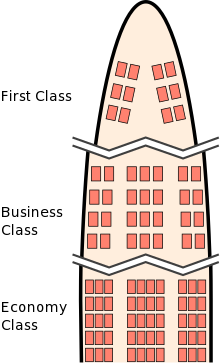Seating plan

A seating plan is a diagram or a set of written or spoken instructions that determines where people should take their seats. It is widely used on diverse occasions. Seating plans have a wide range of purposes.
Formal dinners

At
In Chinese culture, like many other cultures, the place at the table is a sign of social importance.[2] In the United States according to Peggy Post, "tradition dictates that when everyone is seated together, the host and hostess sit at either end of the table. Honored guests (moms, dads, and in-laws) are placed to the host's and hostess's right and then left."[3] This can also be the source of humor.[4]
Politics and government
An election apportionment diagram is a form of seating chart used to visualize electoral results. Often, they are in the form of a hemicycle.[5]
Transportation

Plans are also made for
Entertainment venues
Similarly,
See also
- Seating assignment
- Seating capacity
- Table setting
- Kids' table
References
- ISBN 9780870216206.
- ^ "Dining in Hong Kong: Etiquette". www.internations.org.
- ^ Provost, Jill (October 2, 2007). "Your Seating Plan Handbook". Good Housekeeping.
- ^ "The Definitive Thanksgiving Family Dinner Seating Chart". Science of People. November 18, 2016.
- ^ "Reihenfolge der Wahlvorschläge auf dem Stimmzettel - Der Bundeswahlleiter". Der Bundeswahlleiter (in German). Retrieved 2018-11-04.
- ISBN 9781579992750.
External links
 Media related to Election apportionment diagrams at Wikimedia Commons
Media related to Election apportionment diagrams at Wikimedia Commons
